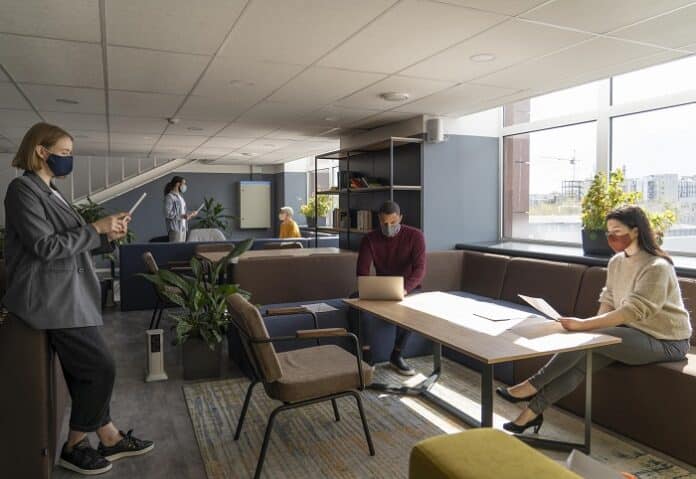The design and layout of an office play pivotal roles in employee productivity and well-being. Among the many factors influencing these spaces, acoustic solutions stand out for their capacity to foster a conducive working atmosphere. Through strategic design and implementation, acoustic office solutions aim to minimise noise pollution—a frequent disruptor of focus and efficiency. This article delves into the myriad benefits these solutions offer, illustrating how they can transform the workplace into a sanctuary of productivity and comfort.
Enhancing Concentration and Productivity
One of the primary benefits of acoustic office solutions is their significant impact on concentration and productivity. In an era where open-plan offices are prevalent, the intrusion of background noise can be relentless. From the clatter of keyboards to the murmur of conversations, these sounds can fragment attention and diminish work quality.
Acoustic solutions, such as sound-absorbing panels and partitions, are ingeniously designed to mitigate such noise. By dampening the ambient sound levels, these interventions create quieter zones that enable employees to focus better, leading to an uptick in productivity and the quality of work produced.
Stress Reduction and Employee Well-being
Noise is not merely a distraction but a source of stress. Prolonged exposure to unwanted sound can elevate stress levels, contributing to a range of health issues, from heightened anxiety to impaired cognitive function.
By integrating acoustic solutions into the office design, businesses can significantly reduce the ambient noise level, thereby creating a more serene and stress-free environment. This tranquillity is essential for employee well-being, fostering a workspace that supports mental health and enhances overall job satisfaction.
Improving Speech Privacy
In any office, the confidentiality of conversations, whether they occur in meeting rooms or across desks, is paramount. Acoustic solutions play a crucial role in enhancing speech privacy by preventing sound from travelling. High-quality acoustic installations ensure that confidential discussions remain private, safeguarding sensitive information.
This is particularly important in industries where discretion is a critical aspect of the business operation. Furthermore, employees feel more comfortable and secure knowing their conversations are not subject to unintended eavesdropping, fostering a culture of trust and integrity within the workplace.
It’s Proven To Work
The effectiveness of acoustic solutions in office design is not merely theoretical but is underscored by successful real-world applications. An outstanding illustration of this is this office redesign for Fred Olsen in Stirling, which showcases how acoustic considerations can revolutionise a workspace. This project exemplifies the strategic integration of acoustic elements to enhance productivity, ensure privacy, and improve the overall workplace atmosphere.
By focusing on noise reduction and sound management, the redesign has created an environment that embodies the core benefits of acoustic solutions, serving as an inspiration for businesses aiming to optimise their office spaces.
Facilitating Collaboration and Flexibility
The modern office thrives on collaboration, yet without the right environment, the noise generated from teamwork can become a hindrance to others. Acoustic solutions cleverly balance the need for collaborative spaces with the necessity for quiet areas. Through the use of modular acoustic furniture, soundproof pods, and flexible partition systems, offices can now create adaptable spaces that cater to both group activities and individual work.
This versatility ensures that employees have access to the right kind of space when they need it, whether for brainstorming sessions, client calls, or focused solitary work. By facilitating this balance, acoustic office solutions enhance the office’s overall functionality and responsiveness to the diverse needs of its workforce.
Enhancing Aesthetic Appeal and Brand Image
Beyond the functional benefits, acoustic office solutions also contribute significantly to the aesthetic appeal and brand image of a workspace. Designers and architects have access to a wide array of materials and finishes, allowing acoustic interventions to seamlessly integrate with the office’s design theme.
From visually striking sound-absorbing panels to elegantly designed acoustic furniture, these solutions can enhance the visual appeal of the office while reinforcing brand identity. A well-designed acoustic-friendly office communicates a company’s commitment to employee welfare and innovation, positioning the brand positively in the eyes of both employees and visitors.
Increasing Space Utilisation and Flexibility
Effective use of space is a critical consideration for any office, particularly in urban areas where real estate comes at a premium. Acoustic solutions can dramatically increase the utilisation of office space. By reducing noise transmission, areas of the office previously unsuitable for work due to noise distractions can become productive spaces.
Additionally, the flexibility offered by some acoustic solutions, such as movable acoustic panels or furniture with built-in sound absorption, allows for the dynamic reconfiguration of the workspace. This adaptability is invaluable in responding to changing needs, whether accommodating growth, facilitating different types of work, or hosting special events.
Supporting Health and Environmental Standards
Finally, it’s important to acknowledge the role of acoustic solutions in supporting health and environmental standards within the office. Many acoustic materials are made from sustainable or recycled materials, contributing to a company’s environmental goals.
Moreover, by improving the sound environment, these solutions directly impact the health and comfort of employees, aligning with standards for occupational health and well-being. The reduced stress and increased comfort levels not only benefit individual employees but also contribute to a more positive and productive work culture.
Image by Freepik





